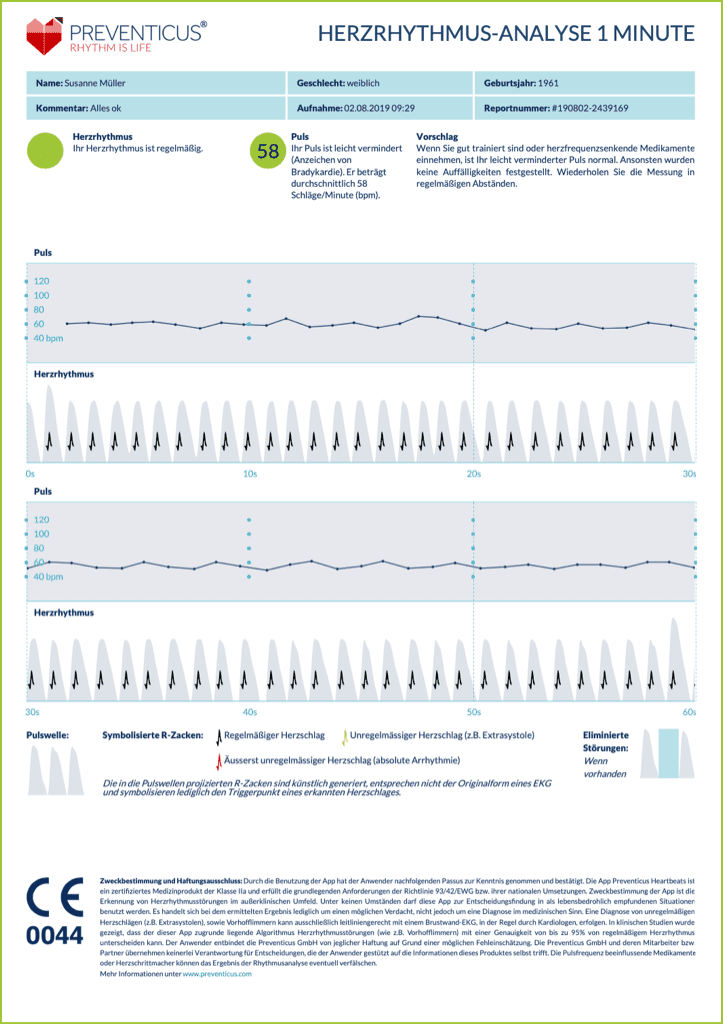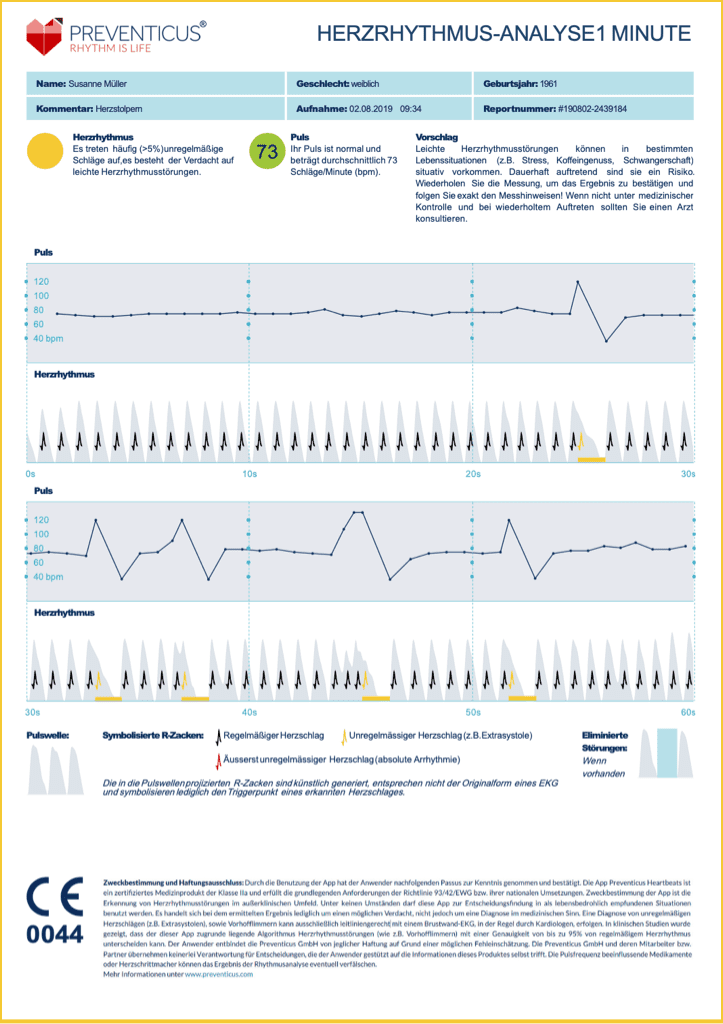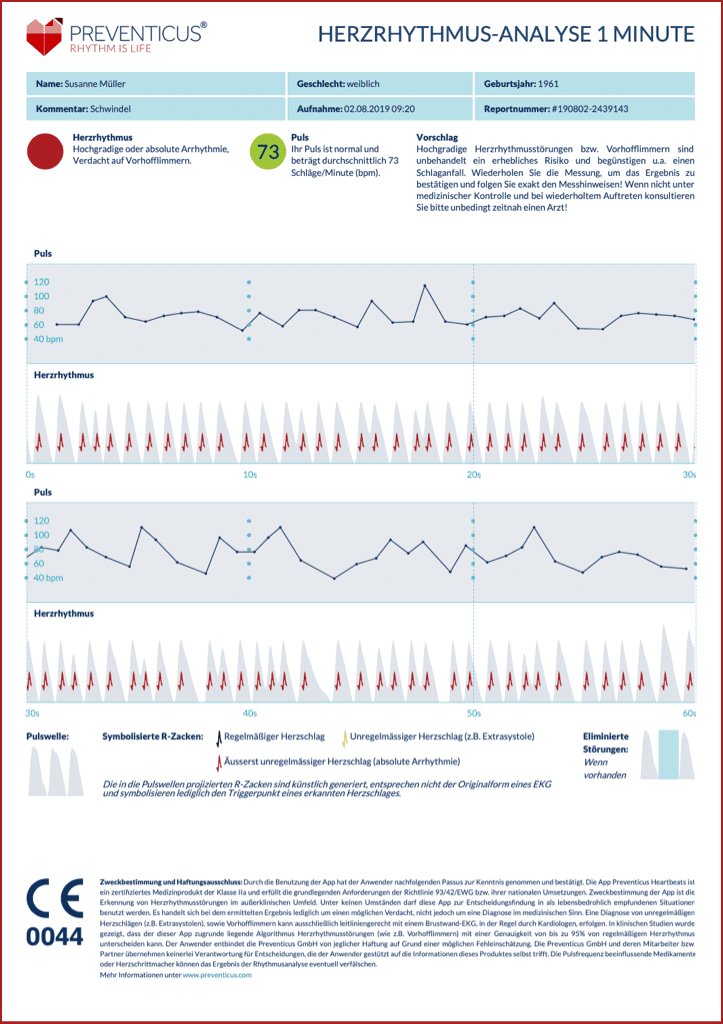Reduce the risk of stroke –
simply in your sleep
The Preventicus Service searches and finds undetected atrial fibrillation, identifying a significant major risk factor for stroke.
Digital precaution with Preventicus
Have your heart rhythm checked automatically while you sleep and you’ll know for sure. Sounds simple? It is. All you need is your wearable monitoring device, such as a smartwatch or a measuring bracelet that offers the Preventicus Service.
Cardiologists recommend a regular self-monitoring of the heart rhythm. Routine medical exams alone are not sufficient to detect occasional atrial fibrillation (the most common heart rhythm disorder).
The purpose of Preventicus is to detect signs of the presence of cardiac arrhythmia in a non-clinical setting. You measure your heart rhythm regularly with the Preventicus service – automatically, while you sleep. Using the PPG sensor in the wristband of your wearable, a pulse curve is continuously recorded and your heart rate data is derived from it. If signs of cardiac arrhythmia are detected, you can save the underlying information in a measurement report. The app on your wearable allows you to print it out. The report shows the original pulse curve over the course of a maximum of 5 minutes and integrates symbolic R-peaks in each cardiac cycle. This allows the attending physician to visually assess the heart rhythm, understand the automatic interpretation and take further diagnostic action if necessary.
The obtained result is purely a suspicion and not a diagnosis in the medical sense of the word. The results obtained are for information only and are in no way intended to replace a personal diagnosis or personal consultation, care or treatment by medical or medically trained personnel.

The invisible danger – undetected atrial fibrillation
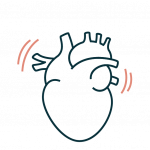
What is atrial fibrillation?
The sinus node, a nerve plexus in the right atrium, controls the heartbeat via electrical signals. It ensures that the heart muscle tenses and relaxes again so that the blood circulates through the body. In atrial fibrillation, this process is disturbed: the signal from the sinus node is superimposed by circling electrical impulses in the atria. As a result, the muscles in the atria tense uncontrollably: they fibrillate and the entire heart rhythm gets out of sync.
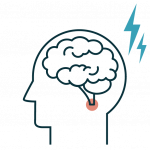
What causes a stroke?
An irregular heartbeat impairs the heart’s pumping capacity: the blood no longer flows regularly, which can lead to blood clots in the atria that can be washed out into the bloodstream. If they get into the blood vessels that supply the brain, it is no longer sufficiently supplied with blood and the oxygen supply is blocked. Typical signs are disturbances or loss of bodily and sensory functions such as severe headaches, speech disorders and paralysis. A stroke is an acute emergency and must be treated immediately. Often the consequences are lifelong disabilities or even death.

Preventicus protects you
Since regular preventive measures from a specialist are often insufficient, cardiologists recommend taking additional preventive measures yourself. Preventicus makes it possible for you to keep an eye on your heart rhythm easily and reliably – independently, regularly and contact-free, while you sleep.
Dr. Heart explains

Mit dem Laden des Videos akzeptieren Sie die Datenschutzerklärung von Vimeo.
Mehr erfahren
Are you at risk?
Cardiovascular disease promotes atrial fibrillation, which increases the risk of a life-threatening stroke. You should participate from the age of 65, or if you are 55 and older and have the following pre-existing conditions:
High blood pressure is an immense strain on the heart, and the probability of a heart rhythm disorder increases due to the permanently high pressure load. You should measure your heart rhythm continuously if your blood pressure is above a value of 140/90 mmHG and also if you are already being treated for high blood pressure.
Diabetics have a two to four times higher risk of heart rhythm disorders. Especially at the beginning of the disease, it is important to keep an eye on the heart rhythm, because atrial fibrillation announces itself sporadically and can then only be detected through targeted prevention.
Have you already had a stroke? Minimize your risk factors and keep an eye on your heart rhythm so you don’t have to suffer this fate again due to atrial fibrillation.
A temporary circulatory disturbance (TIA – transient ischemic attack), which is accompanied by temporary paralysis, speech and consciousness disorders, is triggered by blood clots, which can be an accompanying symptom of atrial fibrillation.
If you have already had a vessel occlusion due to a blood clot (thrombo-embolism), you should be especially vigilant for the risk factor of atrial fibrillation, which promotes the development of blood clots.
Arteriosclerosis is caused by deposits on the inner walls of the arteries. Blood clots can block the narrowed arteries, interrupt the oxygen supply and damage organs. Early detection and treatment of atrial fibrillation protects against the development of blood clots.
If the coronary vessels are narrowed by vascular deposits (CHD – coronary heart disease), the oxygen supply to the heart is not sufficiently guaranteed. As a result, heart diseases can develop, which also include heart rhythm disorders such as atrial fibrillation.
Narrowed arteries in the legs, and more rarely in the arms (PAVK – peripheral arterial occlusive disease), can be a warning sign of narrowed arteries overall. Frequently, the arteries in the heart are also affected. This increases the risk of heart rhythm disorders such as atrial fibrillation.
A heart attack can damage the heart tissue, resulting in the death of heart muscle cells. This impairs the performance of the heart, often as a late consequence, and about one fifth of heart attack patients develop atrial fibrillation.
Chronic heart failure (cardiac insufficiency) reduces the pumping capacity of the heart. The heart is less and less able to supply the body and organs with sufficient oxygen. This limits physical performance and can also lead to atrial fibrillation.
High blood pressure is an immense strain on the heart, and the probability of a heart rhythm disorder increases due to the permanently high pressure load. You should measure your heart rhythm continuously if your blood pressure is above a value of 140/90 mmHG and also if you are already being treated for high blood pressure.
Diabetics have a two to four times higher risk of heart rhythm disorders. Especially at the beginning of the disease, it is important to keep an eye on the heart rhythm, because atrial fibrillation announces itself sporadically and can then only be detected through targeted prevention.
Have you already had a stroke? Minimize your risk factors and keep an eye on your heart rhythm so you don’t have to suffer this fate again due to atrial fibrillation.
A temporary circulatory disturbance (TIA – transient ischemic attack), which is accompanied by temporary paralysis, speech and consciousness disorders, is triggered by blood clots, which can be an accompanying symptom of atrial fibrillation.
If you have already had a vessel occlusion due to a blood clot (thrombo-embolism), you should be especially vigilant for the risk factor of atrial fibrillation, which promotes the development of blood clots.
Arteriosclerosis is caused by deposits on the inner walls of the arteries. Blood clots can block the narrowed arteries, interrupt the oxygen supply and damage organs. Early detection and treatment of atrial fibrillation protects against the development of blood clots.
If the coronary vessels are narrowed by vascular deposits (CHD – coronary heart disease), the oxygen supply to the heart is not sufficiently guaranteed. As a result, heart diseases can develop, which also include heart rhythm disorders such as atrial fibrillation.
Narrowed arteries in the legs, and more rarely in the arms (PAVK – peripheral arterial occlusive disease), can be a warning sign of narrowed arteries overall. Frequently, the arteries in the heart are also affected. This increases the risk of heart rhythm disorders such as atrial fibrillation.
A heart attack can damage the heart tissue, resulting in the death of heart muscle cells. This impairs the performance of the heart, often as a late consequence, and about one fifth of heart attack patients develop atrial fibrillation.
Chronic heart failure (cardiac insufficiency) reduces the pumping capacity of the heart. The heart is less and less able to supply the body and organs with sufficient oxygen. This limits physical performance and can also lead to atrial fibrillation.
That's what your PDF report tells you. Watch the short film.
The algorithm precisely determines the frequent occurrence of extra beats or the presence of an absolute arrhythmia with suspected atrial fibrillation from the pulse curves (see clinical studies).
If more than 5% of all beats are extra beats, the suspicion of a mild arrhythmia is indicated with a yellow traffic light in the Preventicus area of the app. The red traffic light appears when a significant cardiac arrhythmia is suspected (presence of an absolute arrhythmia with suspected atrial fibrillation). In addition, the app informs you about a relevant pulse that is permanently too low (bradycardia) or too high (tachycardia). Any disturbances that occur during the measurement (wobbling, coughing, trembling, etc.) are detected and eliminated fully automatically.
The Preventicus service of your wearable app also generates a PDF report showing the original pulse curves recorded over five minutes and the R-spikes symbolic of each cardiac cycle. This allows your doctor to understand the automatic interpretation and visually evaluate your heart rhythm.
This is what Preventicus stands for.
Healthcare and preventive care can be improved through our new digital technologies. However, this alone would reach its limits if they were not integrated into existing treatment pathways and did not close ranks with medical care and service providers. Our claim to create truly effective solutions for the prevention and management of cardiovascular diseases is therefore being realized with integrated medical care programs involving health insurers, telecare centers and cardiologists.
DIGITAL
TECHNOLOGIES
The high clinical evidence of our products is company philosophy. The Preventicus Heartbeats app has been validated in numerous international clinical studies, making it one of the best clinically studied products in its class worldwide. Currently, among other major projects and campaigns, the "RedStroke" study (Reducing Strokes in Europe) is running with it simultaneously in 7 European countries. This study, one of the largest of its kind, is supported by the European Union under the Horizon2020 program.
MANAGED CARE
A special feature of these programs is not only their social and medical benefits, but also their outstanding cost effectiveness, which has been evaluated in terms of health economics. Using the example of our "Screening and Diagnosis of Atrial Fibrillation" care program, the costs of the program and therapy are lower for a health insurance company than the cost savings that can be achieved through avoided strokes.
PRECISE AND
SCALABLE
With Preventicus, over 12 million rhythm evaluations have been performed to date. More than 3,500 measurements are analyzed daily on our servers, over 100,000 per month.
*As of September 2019 (based on one-minute rhythm measurements).
STRONG
ALLIANCES
Through our contract partner GWQ ServicePlus AG, all German statutory health insurers can participate in our care programs. The Servicegesellschaft des Bundesverbandes Niedergelassener Kardiologen supports the Germany-wide roll-out of our programs. Preventicus is currently receiving significant funding from the European Union within the framework of two Horizon2020 projects (including SME Instruments Phase II) and is being strengthened to establish these innovative care programs throughout Europe.
Disclaimer
Preventicus Heartbeats Core detects atrial fibrillation with an overall accuracy of 96% according to the studies conducted. The sensitivity (true positive rate) is approx. 92%. The sensitivity indicates the probability with which atrial fibrillation is detected as such. In parallel, the specificity (true negative rate) indicates the percentage of users not affected by atrial fibrillation for whom the result „no abnormalities“ is issued correctly. The specificity of Preventicus Heartbeats Core is 99%. Atrial fibrillation can occur sporadically, if it is not present at the moment of measurement, it cannot be detected by Preventicus Heartbeats Core. It cannot be excluded that poor signal quality due to motion artifacts, existing diseases (such as diabetes, vascular diseases or the condition after cardiovascular surgery), medications affecting the pulse rate or pacemakers may falsify the accuracy of Preventicus Heartbeats.
The user of Preventicus Heartbeats Core is aware of a possible misjudgment.
Cardiac rhythm analysis with Preventicus Heartbeats Core is neither used for decision making in acute conditions nor for real-time monitoring of vital functions, nor does it interfere with existing guideline-based diagnostic pathways or therapeutic measures.
Basically, a distinction must be made between atrial fibrillation ( AF ) detection (screening or follow-up) and subsequent AF diagnosis. AF diagnostics are performed exclusively according to guidelines with a chest wall ECG, usually by cardiologists. Preventicus applications are not intended for final AF diagnosis with therapeutic implications, but exclusively for AF screening or AF follow-up without therapeutic implications. A therapeutic implication can only be made based on a real ECG.
PREVENTICUS and its directors, officers, employees, agents, partners, affiliates and licensors assume no responsibility for any decisions you make based on the information, such as whether or not to seek care or treatment from a health care professional. You hereby waive any and all claims you have or may have in the future against PREVENTICUS and its directors, officers, employees, agents, partners, affiliates, and licensors, and agree to indemnify and hold them harmless from and against any and all claims, proceedings, costs, indirect or consequential damages related to your use of the Information. This also applies to lost profits.
© Preventicus GmbH
Ernst-Abbe-Str. 15 | D-07743 Jena | info@preventicus.com
Preventicus GmbH | Ernst-Abbe-Str. 15 | D-07743 Jena | info@preventicus.com

